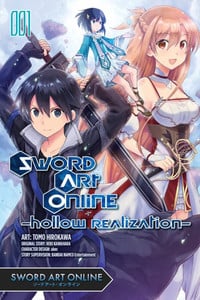Review
by Theron Martin,Sword Art Online: Hollow Realization
GN 1
| Synopsis: |  |
||
Several months after the death game Sword Art Online was successfully conquered and the surviving players thus released from the game, a new VRMMO heavily based on the original – called Sword Art: Origin and set in a land called Ainground – goes online. Kirito and numerous other familiar faces are all invited into the beta test by someone they know and get to discover both its similarities and differences to Aincrad, with the most important of the latter being that you can log out and can respawn after dying. Another odd difference that Kirito quickly encounters is a girl who seems to be a quest-granting NPC, though her quest offers a paltry award and she has other atypical characteristics as well. Is the strange message that Kirito gets – “I'm back in Aincrad” – connected to the NPC girl that he and Asuna come to call Premiere? |
|||
| Review: | |||
This manga is an adaptation of a video game of the same name, which was loosely derived from the core SAO story. Though the source game is the fourth one made for the franchise, it is the first one to get adapted, and that causes some problems. The most important of those is that this story is not part of the canon storyline; it instead follows the alternate storyline established in earlier games, which among other things varies from the canon content by the SAO survivors having completed all 100 levels to beat the game instead of Kirito's victory happening abortively on floor 75. It also has characters in it that never appeared in the canon content and/or appeared in entirely different contexts, most notably Yuuki. As a result, even those familiar with the rest of the franchise may be lost on some points if they have not played the immediate predecessor game, Sword Art Online: Lost Song, or at least read up on its story. That being said, any differences caused by playing SAO all the way through are nonexistent so far, so anyone who's seen both of the first two anime series or read the equivalent novels should be able to make enough sense of it to muddle through. I definitely don't recommend it for franchise newcomers, however. Based on accounts I've read about the game, the set-up presented here seems to follow the game's set-up relatively closely, with the mystery surrounding the NPC girl Premiere standing at the core of the plot. Doubtlessly Premiere is Something Special, as the story beats here have a flavor somewhat reminiscent of Kirito and Asuna's initial encounter with Yui back in the Aincrad arc, and it's definitely too early to spill all of the beans on who/what she actually is That she can actually learn things seems like it should be a more remarkable point than the cast is treating it as being, as game NPCs who aren't specifically supporting companions are usually static in their capabilities, but perhaps the cast is inured to such oddities after encounters with AIs like Yui or Strea, the game-only one who first appears about halfway through. The other interesting twist is that NPCs can suffer permadeath in this game; an entirely different NPC will appear when one is killed. Not sure at all yet what the point is to that, but presumably it's also a key element of the story's mysteries. All of the core cast from the first SAO series is back to join Premiere and try out the new game setting. Joining them are Sinon and Yuuki from the second series and three game-specific characters: the aforementioned Strea (who first appeared in the first game, Infinity Moment), the dagger-using SAO survivor Philia (first appears in the second game, Hollow Fragment), and Seven, an idol who had a prominent role in Lost Song. Hardly anyone beyond Kirito, Asuna, and Premiere get much attention, however, and this is still clearly and primarily Kirito's story. There's also a new villain who seeks to fight Kirito for as-yet-unrevealed reasons, but he seems utterly unremarkable. The same can be said of the story progression in general, which meanders around as it waits for Premiere to develop. Given some of the late developments this volume, hopefully that's setting up something bigger for next volume. The artistic effort is provided by Tomo Hirokawa, an artist who has produced several other manga over the past 15 years (including one installment of the Muv-Luv franchise) but nothing that has caught much interest in the West. While character designs generally remain faithful to the original SAO designs by abec in a design sense, there is a noticeable tendency for the busts of female characters to be emphasized. A few panels make a clear effort to evoke imagery from the anime series, but overall the panel layouts, cutesy elements, and depictions of fight scenes and dramatic imagery are run-of-the-mill. In other words, this volume wouldn't stick out at all if it wasn't associated with a major franchise. Yen Press is releasing the relatively short (158 pages) volume with a one-page illustrated Afterword and greetings from both abec and franchise creator Reki Kawahara. It opens with a color glossy art page and it cover art is well-indicative of what will be found inside. At least one more volume is scheduled. On the whole, the manga is strictly for franchise completionists or those who have played the video games. So far it shows very little worth recommending beyond those audiences. |
| Grade: | |||
|
Overall : C+
Story : C+
Art : B
+ VR action in a not-deadly scenario is a nice change of pace |
|||
| discuss this in the forum (1 post) | | |||
| Production Info: | ||
|
Full encyclopedia details about Release information about |
||